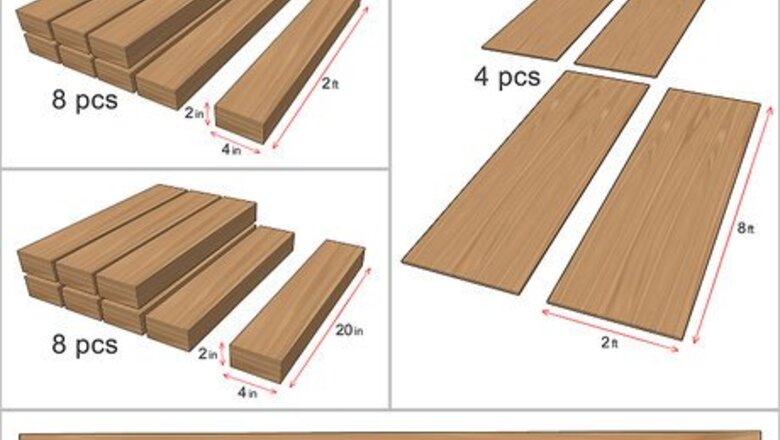
views
Making Freestanding Shelves
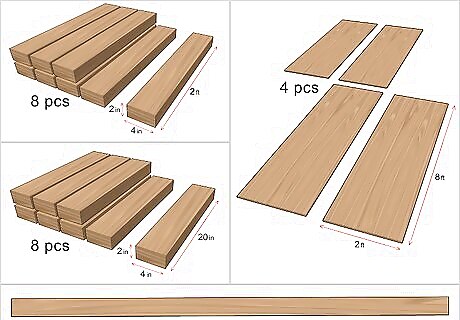
Cut all of your boards and plywood using a circular saw. Look for long, straight boards without any deformities. Use a tape measure to find the length of each board. For this shelf, cut 2 in × 4 in (5.1 cm × 10.2 cm) boards into 8 pieces that are 2 ft (0.61 m) long and 8 pieces that are 20 in (51 cm) long. Then cut 2 8 ft × 4 ft (2.4 m × 1.2 m) plywood sheets in half to make 4 pieces that are 8 ft × 2 ft (2.44 m × 0.61 m). Purchase 16 boards that are 8 ft (2.4 m) long so you only need to make cuts for the short sides of your shelves. Leave 10 of the boards uncut. This shelf is 8 feet (2.4 m) tall, 8 feet (2.4 m) long, and 2 feet (0.61 m) deep. The final measurements for your shelves will vary depending on the size of your garage.
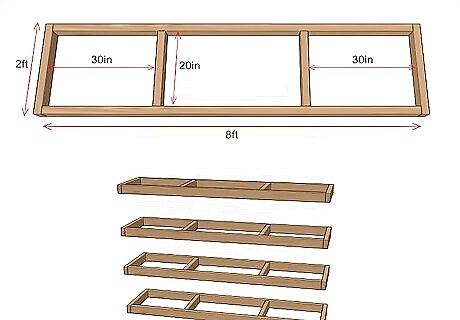
Make a frame for each shelf using 2 in × 4 in (5.1 cm × 10.2 cm) boards. Arrange 2 boards that are 8 ft (2.4 m) long and 2 boards that are 2 ft (0.61 m) long into a rectangle that measures 8 by 2 feet (2.44 m × 0.61 m). Set your 20 in (51 cm) boards parallel to the 2 ft (0.61 m) boards inside the frame about 30 inches (76 cm) in from each side. These boards will help support the weight on your shelf. In total, you will have enough frames to make 4 shelves.
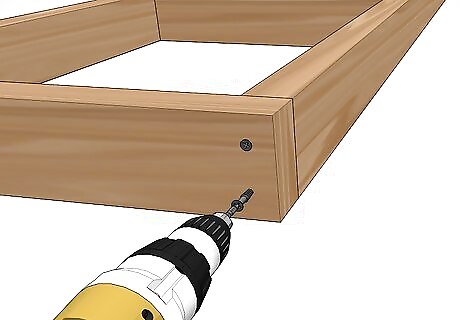
Screw or nail the frame together. Drive 2 nails or screws that are 3 in (7.6 cm) long in each corner with either a hammer or an electric screwdriver. When you're finished with the corners, finish by attaching the support beams in the middle of the frame, using 2 nails or screws on each side. Repeat the process for the 3 remaining shelves.
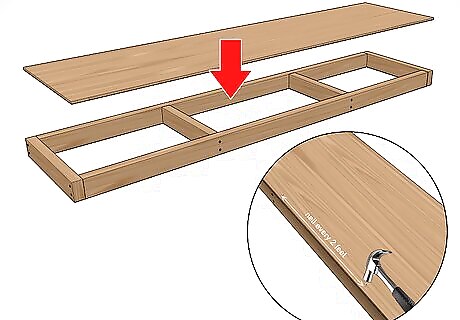
Nail the plywood on top of your shelves. Lay the plywood on top of your shelf frames so the smooth side faces up. Drive 2 in (5.1 cm) nails every 2 feet (0.61 m) along your frame, starting in the corners. Continue securing the plywood for each of your shelves. Use a nail gun if you want to attach the plywood faster.
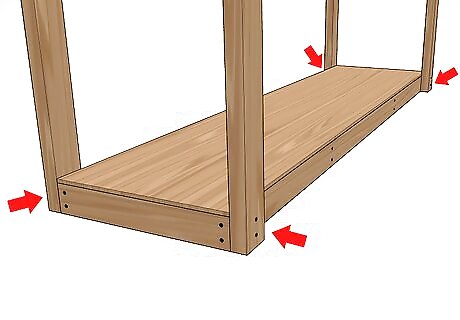
Attach the bottom shelf to 2 in × 4 in (5.1 cm × 10.2 cm) uprights. Clamp 4 boards that are 8 ft (2.4 m) long on the corners of the bottom shelf so they're flush. Start by attaching the bottom shelf at ground level using 2 nails or screws that are 3 in (7.6 cm) long in each corner. Move the bottom shelf up by 1–2 inches (2.5–5.1 cm) if you don't want it resting directly on the ground.
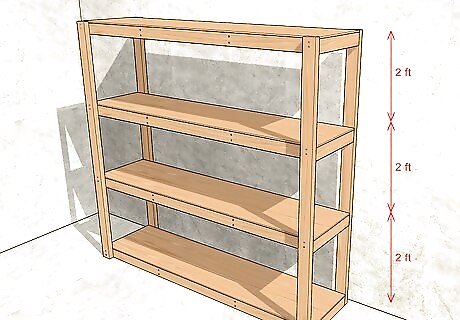
Place the rest of the shelves 2 feet (0.61 m) apart from one another. Clamp a spare 2 ft (0.61 m) board between 2 of the uprights and set your next shelf on it. Use a level to make sure your shelf is sitting straight. Raise the other end of the shelf until it's level and clamp it to the other set of uprights. Secure the shelf with nails or screws, and continue adding shelves until the last one is flush with the top. Have a partner help you lift and maneuver the shelves so you don't damage them or hurt yourself. boards and space your shelves so they're 2 ⁄2 feet (76 cm) apart.}} EXPERT TIP Ashley Moon, MA Ashley Moon, MA Professional Organizer Ashley Moon is the Founder and CEO of Creatively Neat, a virtual organizing and life coaching business based in Los Angeles, California. In addition to helping people organize their best life, she has a fabulous team of organizers ready to de-clutter your home or business. Ashley hosts workshops and speaking engagements at various venues and festivals. She has trained with Coach Approach and Heart Core for organizing and business coaching respectively. She has an MA in Human Development and Social Change from Pacific Oaks College. Ashley Moon, MA Ashley Moon, MA Professional Organizer Make the most of garage wall storage. Install shelving racks and floor-to-ceiling storage cabinets on garage walls to get small, easily scattered garage items up and out of the way neatly. This way, bulky seasonal gear can be accessed safely without toppling piles.
Building Small Shelves on the Wall
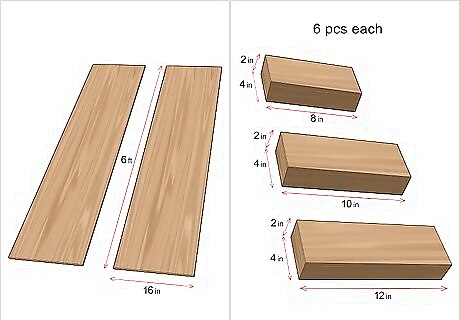
Saw your boards and plywood to size. Use a circular saw to cut ⁄2 in (1.3 cm) plywood into 2 shelves that are 16 in (41 cm) deep and 6 ft (72 in) long. Cut your 2 in × 4 in (5.1 cm × 10.2 cm) boards into 6 pieces each that are 12 inches (30 cm), 10 inches (25 cm), and 8 ⁄2 inches (22 cm). These pieces will form your brackets. Some home improvement stores can cut your plywood to size for you. Ask an employee at the store if they are able to cut your wood.
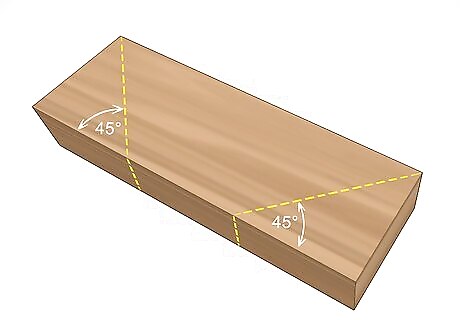
Mark and cut 45-degree angles on the ends of your 12 in (30 cm) pieces. Use a speed square and a pencil to mark your angles. Make both angles on the same side so your boards look like trapezoids when they're cut. Cut along the angles with your circular saw. Speed squares help you mark angles quickly, and they can be purchased from your local hardware store.
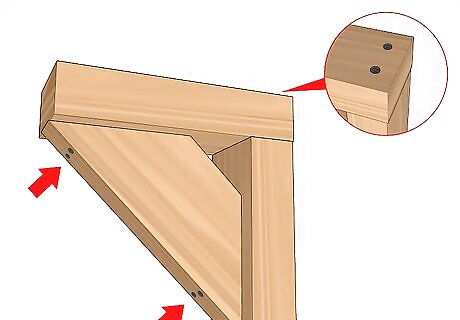
Make 6 triangular brackets from your 2 in × 4 in (5.1 cm × 10.2 cm) boards. Form an L-shape with your 10 in (25 cm) and 8 ⁄2 in (22 cm) pieces. Attach the boards at their joint with 2 screws that are 2 ⁄2 in (6.4 cm) long and an electric screwdriver. Set the piece with the angle cuts inside the L-shape so it forms a triangle. Screw the board in place using 2 screws on each end.

Drive the brackets in your garage wall. Use a stud finder and a pencil to mark the spots along your wall where you can attach your brackets. Plan to put the first set of brackets 16 in (41 cm) apart and the third bracket 32 in (81 cm) away from the second. Hold the side of the bracket with the 8 ⁄2 in (22 cm) board against your wall, and use 4 screws per bracket to attach them to the wall. Repeat the process for your second shelf. Finding the studs is especially important if you plan to store anything heavy on your shelves. Adjust the height of your shelves depending on what you want to store on them. Usually, 16 inches (41 cm) between the shelves is enough.Tip: If you plan on storing heavy bins or items on your shelves, place an extra bracket 16 inches (41 cm) between the second and third bracket to prevent bowing.

Attach the plywood on top of the brackets. Set your plywood pieces on your brackets and make sure they are flush with the wall. Use 4 screws that are 2 ⁄2 in (6.4 cm) long per bracket to attach your shelves. Once your shelves are secure, you can start loading your items on them.
Hanging Shelves from the Ceiling
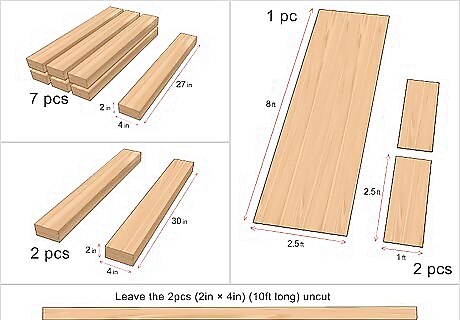
Cut your boards and sheet of plywood. Leave 2 of your 10 ft (3.0 m) boards uncut. Cut the remaining 3 boards into 7 pieces that are 27 in (69 cm) long and 2 pieces that are 30 in (76 cm) long. Use your saw to cut the plywood into 1 sheet that's 8 ft × 2 ⁄2 ft (2.44 m × 0.76 m) and 2 pieces that are 1 ft × 2 ⁄2 ft (0.30 m × 0.76 m). The final shelf measures 10 feet (3.0 m) long and 2 ⁄2 feet (0.76 m) deep, and will hang 26 inches (66 cm) from the ceiling. Your shelves may vary in size depending on the size of your garage.
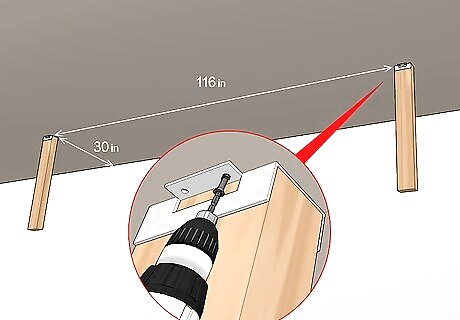
Attach 2 boards that are 30 in (76 cm) long to a ceiling beam with a tie connector. Climb a ladder and find a ceiling beam that extends 30 inches (76 cm) from the wall. Attach a tie connector with 3 in (7.6 cm) screws to the ceiling beam with an electric screwdriver. Place the other tie connector 116 inches (290 cm) apart from the first one and screw it in. Put a 30 in (76 cm) in each tie connector with screws. Tie connectors can be purchased at your local hardware store.Tip: Put your shelf above your garage door to keep your shelves out of the way. Use the shelf to hold seasonal items that you don't use very often, such as Christmas lights.
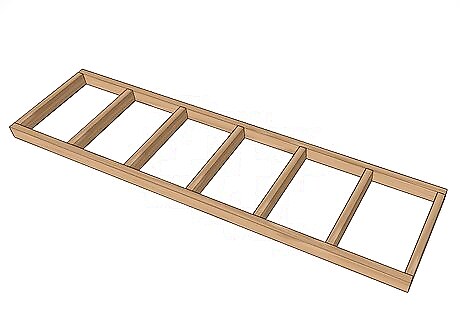
Build your shelf frame using 10 ft (3.0 m) and 27 in (69 cm) boards. Make a rectangle that's 10 ft × 2 ⁄2 ft (3.05 m × 0.76 m) with your boards. Arrange the rest of the short boards parallel to the side of the frame inside the rectangle at 2 ft (61 cm) intervals to create supports. Use 2 nails at each connection to secure the boards and finish your frame.
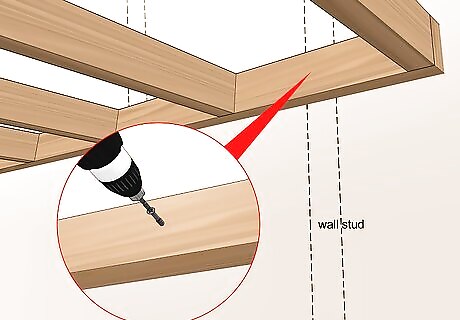
Screw one side of the shelf to your garage wall. Hold the shelf frame so the bottom is level with the ends of the boards hanging from the ceiling. Use 3 ⁄4 in (8.3 cm) screws in the middle of the board every 18 inches (46 cm) to secure the shelf to wall. Have a partner help you lift and support the board while you secure it to the wall.

Attach the other side of the shelf to the boards hanging from the ceiling. Make sure the bottom of the ceiling supports are flush with the bottom of the shelf. Drive 2 nails through the supports with a hammer to secure them in place. Use a nail gun if you want to drive the nails quickly.
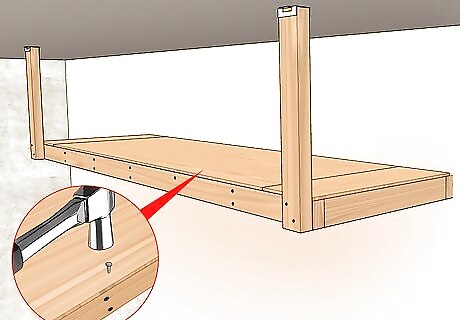
Secure the plywood on top of your shelf with nails. Put the 1 ft × 2 ⁄2 ft (0.30 m × 0.76 m) sheets flush with either end of the shelf. Nail the sheets down in each corner. Then, set the 8 ft × 2 ⁄2 ft (2.44 m × 0.76 m) piece of plywood in between the smaller sheets and slide it so the edges are flush with the frame. Put in a nail every 18 inches (46 cm) along the front of the shelf. You don't need to secure the plywood on the back of the frame.




















Comments
0 comment